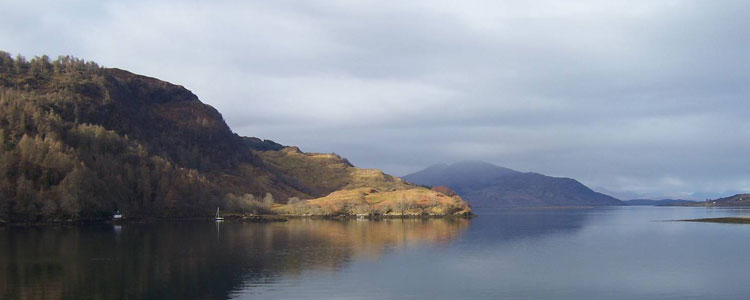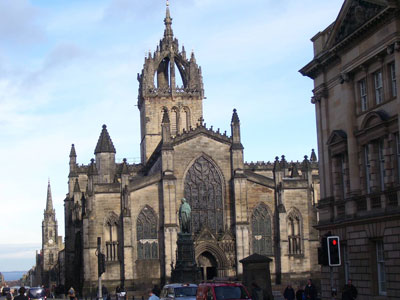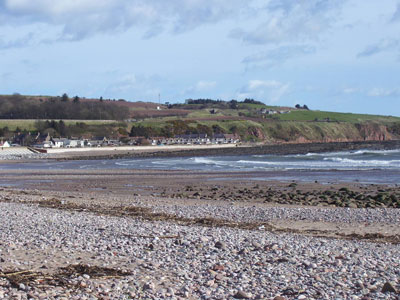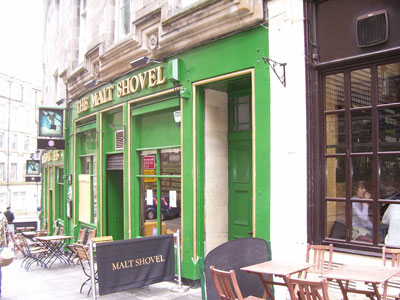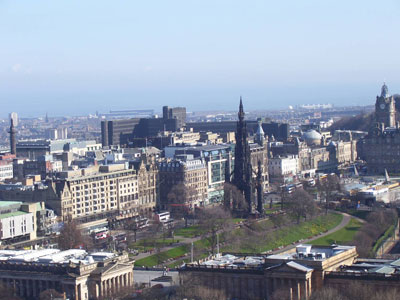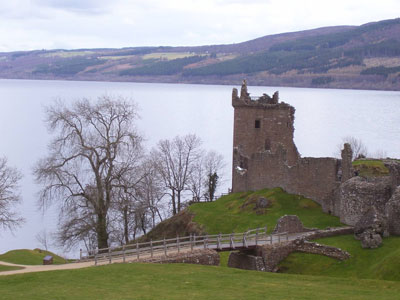Spring in Scotland
by Marvin Herman & Judy Licata; Delavan, Wisconsin
When making our travel plans for early spring 2011, we decided to eschew the damaging rays of the tropical sun with a journey to the Highlands of Scotland.
Settling in
Our flight from Chicago landed in Edinburgh a considerable number of hours before check-in time at the Old Waverley Hotel (43 Princes St.), located across from the Waverley train station (which we accessed via a Lothian Bus [£3.50, or $5.50, each] from the airport).
We chose the Old Waverley ($120 per night, double, including a full Scottish breakfast) because of its proximity to the train, which we planned to take to Stirling four nights later.
After a short delay at check-in, we were given a large, sunny room (No. 415) with a nice view of busy Princes Street and Edinburgh Castle in the distance.
For lunch, we went out to a pub called The Castle Arms (6 Johnston Terrace) in Edinburgh’s Old Town. The good news is that we had pints of creamy ale, a wonderful sausage and mash with meat gravy. The not-so-good news is that it cost the equivalent of $40 for the two of us — not exactly what we would pay for a pub meal at home.
Following lunch, we walked the streets and browsed in the shops before returning to our hotel for the night.
Day-tripping
After a huge breakfast of “tatties and neeps” (mashed potatoes and turnips), haggis (mysterious parts of sheep combined with spices and breading), black pudding (blood sausage), eggs and toast, we boarded the No. 15 bus at the train station and headed to Roslin to visit Rosslyn Chapel, featured in the best-selling book “The DaVinci Code.”
As we neared our destination, the clouds blocked the sun, a chill descended and we wished we hadn’t left our jackets in the hotel room. It had been warm when we started and we ventured out only in shirts and sweaters.
After a tour of the chapel and a talk by the knowledgeable docent Holly on the features of this small but interesting building, we strolled around on our own, locating some of the “green men,” old pagan symbols of nature or fertility. Entry cost £6 each.
On the bus back to Edinburgh, we hopped off at the New Town and walked Rose Street Lane and George Street, admiring the wonderful Georgian architecture that makes that part of the city so interesting — a contrast to the medieval buildings and twisted alleyways of the Old Town and the Royal Mile, between the castle and Holyrood Palace.
Stopping for directions, we continued to the Oxford Bar, a pub made famous by Ian Rankin in his books about the fictional Scottish Inspector John Rebus. The tiny front bar with the larger room in back was exactly as described.
Exploring Edinburgh
The next day we toured Edinburgh Castle, where we purchased Historic Scotland Explorer Passes (£21 each — slightly less than the in-season rate of £27, senior, or £34 per adult), allowing us to visit any castles on their list on any seven days within two weeks of the purchase date. This was to save us over £100 in entry fees over the course of our visit to Scotland.
Wanting to see the castle at our own pace, we took the audio tour, even though there were free guided tours available. We spent just over two hours at the castle, though one might easily spend the entire day there.
We strolled the entire Royal Mile, admiring the modern Scottish Parliament building and stopping at a secondhand music shop to acquire some drum and bagpipe CDs featuring music of the Highlands.
We also visited a private attraction called The Real Mary King’s Close (2 Warriston’s Close), an entertaining tour (£12 per adult) of the underground streets and dwellings beneath the Royal Mile where hundreds of people lived from the 16th century until the 1930s. The tour was led by a docent posing as one of the actual inhabitants of the “close,” or alleyway.
An Edinburgh friend, joining us for dinner, had booked a table at Dubh Prais (123b High St.), a restaurant on the Royal Mile featuring Scottish food. The food was excellent, especially the filet of Angus beef with a rich mushroom sauce. Service, presentation and quantity were top-notch. The cost was £109, or $175, including wine and service, for three.
On to Stirling
After breakfast the next morning, we were off to take the 50-minute train trip (£7 per person, one way) from Waverley station to the smaller city of Stirling, where we would spend the night. The day grew warm, and we struggled to drag our bags up the hill from the Stirling train station to Barceló Highland Hotel (29 Spittal St.), which cost $107, including breakfast.
The staff was friendly and our room was quite nice, but it lacked the character of our room in Edinburgh. The building, itself, a former high school, reminded us of the Hogwarts School of “Harry Potter” fame.
After settling in, we were off to Stirling Castle, part of which was closed for renovation. This proved to be a problem with several sites we had planned to visit in Scotland. However, the trade-off was that we avoided the jostling of the crowds and the long lines at most of the popular tourist venues.
After our visit, we walked down the hill to Darnley Coffee House, said to be the best tea house in Scotland. We enjoyed a pot of Earl Grey in the cozy room of the 16th-century building.
The next day, after a breakfast that included smoked Scottish salmon and local cheeses, we had the hotel call a taxi to take us to the National Car Rental office, where we picked up the car we had rented through Auto Europe (888/223-5555). Our automatic-transmission vehicle, a 2011 Mercedes-Benz hatchback, cost about $450 for the 13-day rental.
The only extra charge we had was a “road license fee” ($2.50 per day), charged to drivers from outside the UK and payable on return of the vehicle at the airport in Edinburgh.
Centering my concentration fiercely on the road to avoid compensating to the left, we made our way out of Stirling. By late morning we were walking along the “bonnie banks” of Loch Lomond.
With snow-covered peaks in sight, by late afternoon we reached the town of Dornie and found ourselves on bar stools at The Clachan (13 Francis St.). Our pub keeper, Don, his accent thick with Highland burr, poured us our first “wee dram” of a 10-year-old Talisker single malt distilled on the Isle of Skye.
After our earlier examination of several “country hotels,” actually properties run by people from Eastern Europe, we spent the night (£50) at a cozy B&B recommended by Don called Sonas (phone 01599 555733, angelagill@hotmail.com).
We enjoyed dinner at The Dornie Hotel, next to The Clachan. There was a wood fire burning in the grate, and we found our selection of fish and chips (£10 each) quite tasty.
Dornie is located between Invergarry and the Skye Bridge, and its main attraction is Eilean Donan castle, set on an island in a small lake. The castle, built in the 13th century, is privately owned, and many millions have gone into furnishing it as an Edwardian country house.
Unlike previous castles we have visited, it is not simply a stone shell. People could well live in it today in luxury. Yet it was the outer part of the castle, and its fabulously situated location, that took our breath away (entry, £5 per person).
Isle of Skye
Crossing the toll-free Skye Bridge, I noticed that the gas gauge showed half empty so stopped to fill the tank. I was shocked to discover that, at £1.32 per liter of regular unleaded gas, the total was £45 ($70).
For the next few nights we had booked a B&B (£70 per night) on the Isle of Skye called Kiltaraglen House (phone +01478 612435), near Portree. After being greeted by the innkeeper, Pam Simmister, we sat in the comfortable living room and enjoyed a repast by the fire while the rain fell outside the large picture window. Breakfast was both beautifully cooked and lovingly served and included porridge with a sauce made of whiskey and honey, a Skye specialty. Driving to the north part of the isle, we discovered its attraction is its expansive natural beauty — water, mountains, fields and woods.
We had wanted to visit Dunvegan Castle, but it was not yet open for the season, so we headed toward Talisker Distillery in Carbost, the only such facility on Skye. The route was misty and bleak, the Cuillin Mountains looming over the road.
Along the A863, south of Dunvegan Castle, we saw a sign for a broch called Dun Beag. A broch is a circular stone dwelling inhabited by, some think, the Picts 2,000 years ago. We hiked up and explored Dun Beag, shooing away the sheep grazing in the surrounding field.
After a worthwhile visit to the distillery, which included a free hour-long tour, we stopped at The Aros Experience (Viewfield Rd.) in Portree, where art and craftwork from Skye are displayed. Musical and dance performances are also held there.
While Judy visited the bookstore and explored the center, I took a four-mile hike in the forest that ran back along the shore of a small nearby loch, a route I found, among others, online at www.walkhighlands.co.uk/skye.
Loch Ness
After breakfast, we began our drive toward Loch Ness.
We were heading toward Urquhart Castle, which we visited for free with our Explorer Pass (entry usually costs £5.50 per person). First we viewed a short film relating the history of the castle, then a curtain opened along a huge glass wall and there, across a beautifully kept, sweeping lawn, was the castle, standing on the bank of the fabulous Loch Ness.
Although the castle is a ruin, it has been made very accessible for visitors, with metal stairs and landings. We didn’t feel this modern addition diminished the experience of the castle in the least.
Next we went to see the Loch Ness display at Drumnadrochit, located at the Loch Ness Centre (£5.50 each). This included an excellent recitation of the history of Nessie, the fabled monster, which began in 1933 when the earliest reports of her existence surfaced. All of the old films and still photos of Nessie were presented and explained. It is an attraction not to be missed, even by skeptics.
Leaving Nessie behind, we turned off the main road onto the less-traveled A831 to see 4,000-year-old Corrimony Cairn near the village of Cannich. The pile of stones, which probably was a site for worship, is surrounded by standing stones, and we were able to go right up to it and crawl inside.
Military sites
Afternoon turned to evening, but we had booked no accommodation for the night. We reached the town of Nairn, where there were several B&Bs. We took a large room (£60) at Hay Lodge (8 Crescent Rd.), where we were the only guests so didn’t mind that the bath was not en suite.
We had an enjoyable meal (£30, total) across the street at The Bandstand Restaurant, overlooking Moray Firth, a North Sea inlet which Nairn shares with the city of Inverary.
The next morning we headed out of town toward Fort George, a large military installation built in the 18th century as a nervous response to the Battle of Culloden in April 1746. The fort is quite extensive and took about two hours to tour. It had interesting displays depicting the lives of officers and men stationed there in the late 1700s.
We next tried to visit Cawdor Castle, reputedly the castle of Shakespeare’s “MacBeth.” Finding it to be closed for renovation, we stopped along the B9006 to visit the Cairns of Clava, a collection of three cairns with standing stones about 4,000 years old.
We next visited Culloden Moor (£6 each, off season), site of the tragic battle in which the Jacobites supporting Bonnie Prince Charlie were slaughtered by the British troops of the Duke of Cumberland in about an hour’s time. The visitor center had a wonderful filmed reenactment of the battle presented in a circular theater, the action projected on the walls. We felt as if we were in the midst of the battle as the ill-equipped and outnumbered Scots were cut down.
We had the opportunity to visit with docents and ask questions about the battle and the weaponry before going out onto the moor, itself, standing where the actual battle was fought.
We had booked a B&B in Navidale, just north of Helmsdale, called Navidale House Hotel (phone +01431 821 258), operated by Florence Seale and her husband, Larry. We arrived at the 18th-century house, built for the Dukes of Sutherland as a hunting lodge, in a drenching downpour. A coal fire was burning in the cozy bar.
We shed our wet coats and sat in large, comfortable chairs in front of the fire chatting with Larry and his friend Stewart, the town butcher, discussing food, travel and local lore. We were then shown to a large room overlooking the North Sea, its waves crashing on the shore below.
The room, as exquisitely furnished as the rest of the house, had an impressive four-poster bed and an en suite bath (£79, including breakfast).
On to Orkney
After a full Scottish breakfast, we headed off toward Scrabster, where we would take the 1:15 ferry to Stromness, on the west side of the Orkney mainland. After buying our tickets and passage for the car at the ferry office (£67, total), we headed toward a small café adjacent to the ticket kiosk.
We were not surprised to discover the ferry to be less than one-fourth full during early April.
After a smooth two-hour voyage, always in sight of the steep headland (“ness”) along the gray waters of the North Sea, we reached Stromness.
Our self-catering accommodation on Mainland Orkney, Cullya-quoy, was located in the town of Houton near Orphir. Our host, John Shearer, had given us detailed instructions on how to find the house, and we located it with little problem.
He met us at the house, since we had notified him by e-mail of the time of our ferry arrival, and he gave us a detailed tour. We paid £200 for the four nights we would be staying there. The house, just a few years old, was large, warm and comfortably well equipped.
April had come to Orkney in the form of a chilly, rainy morning, but we were quite comfortable over our self-prepared breakfast of eggs, onions and cheese, the ingredients all purchased in Stromness at a large supermarket.
We dedicated the day to seeing the main outdoor sites of Orkney: the Standing Stones of Stenness, the Ring of Brodgar, Maeshowe and Skara Brae. All these are Neolithic structures thousands of years old.
While Orkney has good, though narrow, roads, they are not marked particularly well, but we were able to find everything we were looking for and more. The good news — the roads were few in number and there were not many cars on them. We had many maps of the area, but few showed all the locations on Orkney with any detail. For example, the smallest towns were left off the maps.
The gloom on Orkney was palpable — it seemed a hard land — but the friendliness of the people on the island was exceptional, even compared to the affability of the people we met in other places throughout our journey.
Traces of life in the Stone Age
The next day, after breakfast and an intentionally slow departure, we drove to the city of Kirkwall on the east coast. After negotiating its busy, narrow streets, we headed for the Tomb of the Eagles, a privately owned site and farm where Neolithic artifacts were discovered. On the way, we stopped at the Orkneyinga Saga Centre to see exhibits on the Norse and Icelandic saga that are part of the Orkney culture.
Behind the center, along the headland, we visited St. Nicholas Round Kirk, a ruined church built in 1122. There was also a cemetery and the remains of a Norse manor house called Earl’s Bu.
We paid £5.50 each at the tomb and heard a presentation on what was found there, which included skulls, farm implements and the tomb, reachable after a walk of about a mile along the headland with stunning views of the sea. The journey, itself, warrants a visit there.
When we reached the tomb, we saw that it was accessible only by a wheeled sled upon which you lie in a supine position, pulling yourself along by a rope until the inside of the tomb is reached. After our tour, we had some exceptionally good Orkney ice cream at the visitor center.
From Cullya-quoy, we headed out on an unnumbered road to the Corrigall Farm Museum in Harray Parish. Although it seemed to be open for business, no attendant was present, so we browsed around the buildings with other visitors and left after a short time. Old farm implements were the main feature of this site.
After a brief time spent trying to find the road to Evie, we made our way to the Broch of Gurness, a group of Pictish dwellings. Then we drove to Birsay and the Earl’s Palace, a 16th-century ruin, ending our touring for the day in Stromness.
The next day it was time to conclude our Orkney adventure. In Kirkwall, we located the Halston ferry terminal, about a mile out of town, where we would board the overnight ferry M.S. Hjaltland to Aberdeen. NorthLink Ferries charged $360 for a sleeping cabin for two people and passage for our vehicle, which we booked via the Internet (e-mail mail@aferry.com) before we left the US.
After locating the terminal, we returned to Kirkwall to spend some time shopping and strolling the narrow streets along the harbor, making use of our umbrellas in the rain.
Following a brief visit to St. Magnus Cathedral, a good example of Norman architecture and worth a visit if in Kirkwall, we decided to have dinner at Helgi’s, a waterfront pub on Harbor Street. It was warm and cozy, with a friendly, traditional Orkney atmosphere, complete with a coal fire.
We slept well on the ferry, feeling the roll of the ship plowing through the North Sea. At about 6 a.m. there was an announcement that the vehicles would need to be offloaded by 7, then we could return to the ship for breakfast if we wished. We did return to the ferry to shower and enjoy a cup of tea with biscuits before leaving for the last phase of our journey in Scotland.
On to St. Andrews
Heading south out of Aberdeen, a gray city on the River Dee, we drove toward Stonehaven, a nice, little seaside resort town, and wandered the streets to get the feel of the place. Next we drove to Glamis Castle, the former residence of The Queen Mother, paying £8.50 each for a guided tour.
Rod, the docent, took us and a dozen others through 10 rooms of the massive and luxuriously appointed castle. After a visit to the shop and a walk around the grounds, we departed for St. Andrews, a bustling college town known mainly as the world center for the game of golf and also now recognized as the alma mater of Prince William and his wife, Kate.
We visited the tourist information center to secure a place for the night, booking accommodation at the Drumoig Golf Hotel in Leuchars, an area outside of St. Andrews. We had a large room with a view of the golf course. The size of the room allowed us to bring in all of our luggage and repack for our flight two days later.
The rest of our day was spent back in St. Andrews. We strolled over to The Old Course to watch the tourists tee off at a cost, we heard, of £185 per round plus caddie fees. We were also told that one must reserve a tee time months in advance and have a certain proficiency at the game, which closed the door on my aspirations to play the course. (The St. Andrews website lists prices at the Old Course from £64 to £140 per person, depending on the season.)
We visited St. Andrews Castle and the town’s cathedral, where I climbed the 156 steps to the roof of St. Rules Tower, enjoying the wonderful views of the surrounding area.
We next headed toward Kinross, near Loch Leven and a castle, like many in Scotland, with a connection to Mary, Queen of Scots, who was imprisoned there. The castle is reachable only by boat, and the howling winds this day kept the boats in their nousts (secure moorings).
Returning to Kinross, we stopped for a pint at The Salutation Hotel’s public bar (99 High St., phone 01577 863325). We particularly enjoyed the rollicking atmosphere there and the thickly accented discussion on the location of the best mince pies in Scotland. One of the patrons was fond of his recipe for cabbage and bacon and shared it with us.
We decided to book a room at the hotel (£55 including breakfast).
That night, our last in Scotland, we collapsed in bed, exhausted, knowing that we had enjoyed a great experience in a beautiful and exciting land and had met some of the most wonderful people in the world.

